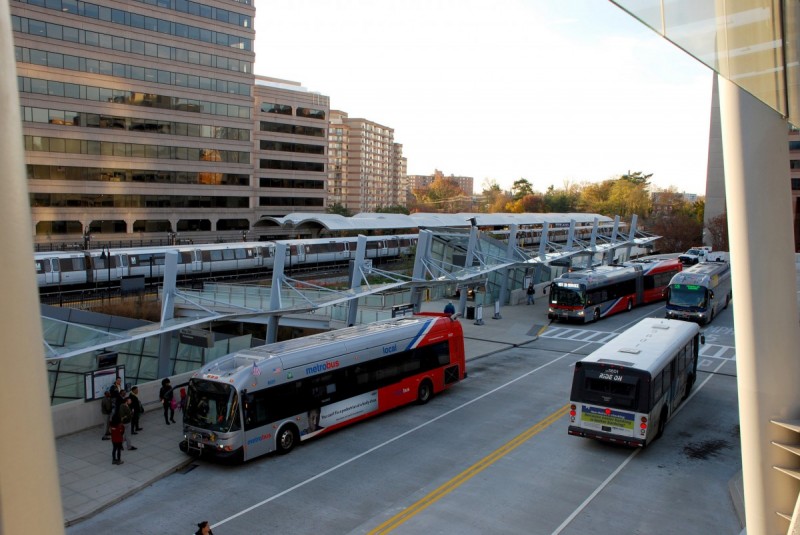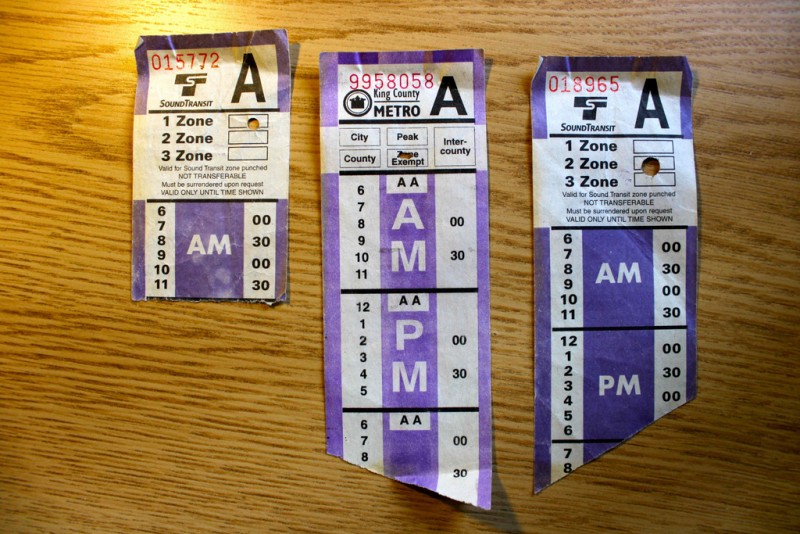Metro’s union is right: Bus to rail transfer fares are unfair

Image by BeyondDC licensed under Creative Commons.
ATU Local 689, the union representing most WMATA employees, recently released a detailed proposal for improving Metro. Its suggestion of a flat fare got most of the press attention, but it has 13 other proposals, many excellent. One I agree with completely: making transfers free between bus and rail.
After the fare increase planned for July 1, 2017, most buses will cost $2.00 with a SmarTrip card. That's not out of line with comparable systems, but one thing is way out of line: If you ride a train and then transfer to a bus, you still pay $1.50 (the bus fare less a 50¢ discount). Most other large transit systems give free transfers or much bigger discounts.
This table compares fares for combo trips in the eight cities with the highest transit usage. Since our rail system’s fares vary based on how far you travel, it’s more complex to compute the bus-to-rail fare, so for simplicity let’s look at how much you’ll pay for a bus trip once you’ve already paid for a rail trip from some other location.
| City & agency | Bus fare (w/card)1 | Bus fare after rail | Bus fare after other rail |
|---|---|---|---|
| Washington (WMATA) after 7/1/17 | $2.00 | $1.50 | FREE from VRE and for MARC or VRE pass holders |
| Washington (WMATA) before 7/1/17 | $1.75 | $1.25 | |
| Philadelphia (SEPTA) | $2.25 | $1.00 | $1.65 from PATCO2 |
| Chicago (CTA) | $2.00 | 25¢ | Full fare from Metra |
| New York (NYCT) | $2.753 | FREE | Full fare from LIRR, Metro-North, NJ Transit, and PATH |
| Atlanta (MARTA) | $2.50 | FREE | No other rail |
| San Francisco (MUNI) | $2.50 | FREE | $2.00 from BART |
| Los Angeles (LACMTA) | $1.75 | FREE | FREE from Metrolink |
| Boston (MBTA) | $1.70 | FREE | Full fare from commuter rail
but free for pass holders |
1 All fare calculations assume you have the electronic fare media for that city. Most agencies offer better fares for people with the card (SmartTrip in Washington, MetroCard in NYC, Clipper in SF, Breeze in Atlanta, etc.)
2 Riders transferring from PATCO to select city train and bus lines can buy a round-trip ticket for $3.10, for an effective per-direction fare of $1.65.
3 Riders using the pay-per-ride MetroCard also get an 11% fare bonus when putting $5.50 or more on the card, making the effective fare for riders who don’t have passes as low as $2.48.
By this computation, the cost to get on a Metrobus after riding rail is more expensive than on any other system in the eight cities where people ride transit the most. Five offer free transfers, and of the other three, Metro is by far the stingiest with its transfer discount.
WMATA doesn't talk about this inequity
Messaging from the agency around bus fares usually ignores transfers. For instance, When announcing the latest fare hike proposal last October, the WMATA press release read:
For bus riders, one-way local bus fares would increase from $1.75 — among the lowest nationally — to $2.00.
But a lot of people don’t just ride the bus. They take a bus from home to a Metrorail station and then ride the train, and back again in the evening. Or a bus to a train to another bus.
That’s not just because they are using a lot of transit. Large parts of the bus network are designed as feeders to the rail system. In fact, many buses don’t go downtown at all, but end at a Metrorail station. When Metro opened, many existing bus lines were cut back to the nearest rail station, with the expectation that riders would take the bus only locally or to the nearest rail station rather than all the way to a distant job center.
New York may have the highest bus fare at $2.75, but a bus plus rail trip is also just $2.75. You can't ever take a Metrobus and Metrorail trip for only $2.75. It's definitely misleading to say Washington bus fares are lower than in other cities.
Old paper transfer slips from Sound Transit and King County (Seattle, Washington). Image by Oran Viriyincy licensed under Creative Commons.
Free transfers for Metro?
WMATA could have made free transfers part of a fare increase package. There’s precedent for that, most recently in Los Angeles. LACMTA used to charge full fare for a bus ride after a subway ride (and even switching from one bus to another), but instituted free transfers in 2014 as it raised the base fare from $1.50 to $1.75.
Metro's variable rail fares should not be a problem. You already get a 50¢ discount if you ride rail after riding bus (and pay for both with the same SmarTrip). WMATA could simply increase that discount to $2.00, the full bus fare. If your rail trip is cheaper, it's free; if more, you pay the extra.
There are other good reasons to institute free transfers. Because there’s no free transfer, and because the base bus fare (to compensate somewhat) is lower than elsewhere, many poorer residents ride the bus long distances on the lines which don’t just end at a rail station. The trip from Southern Avenue to Foggy Bottom on the 32 local might be excruciatingly slow compared to a two-train trip, but it’s cheaper. This exacerbates a class disparity between rail and bus riders.
Kudos to the union for raising this issue. I wish WMATA board members would bring it up more (or at all) when discussing fare hikes.
